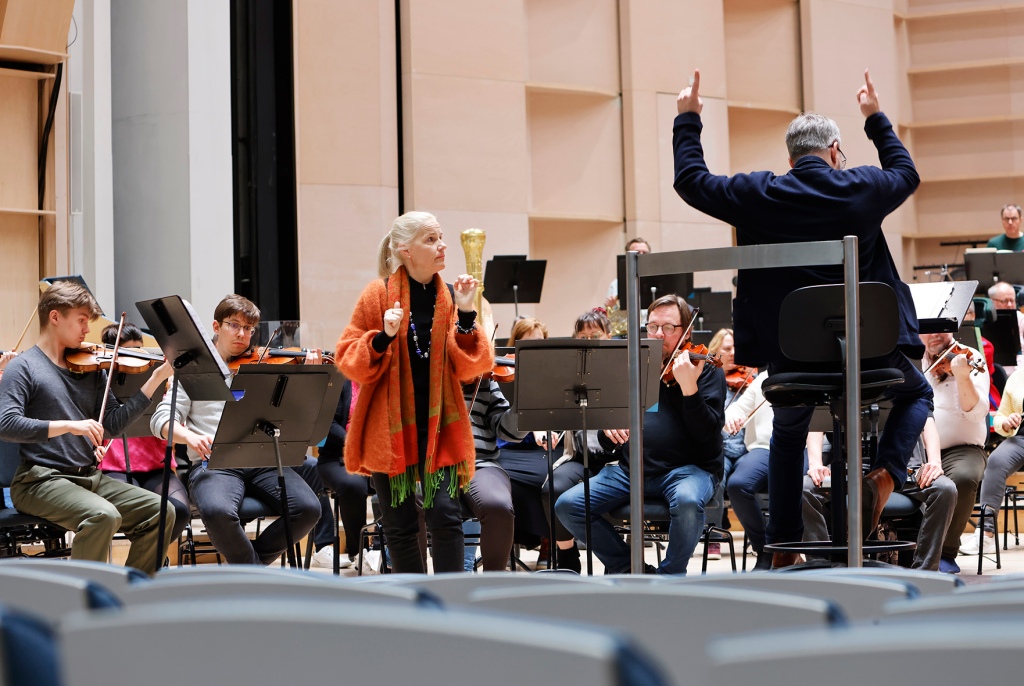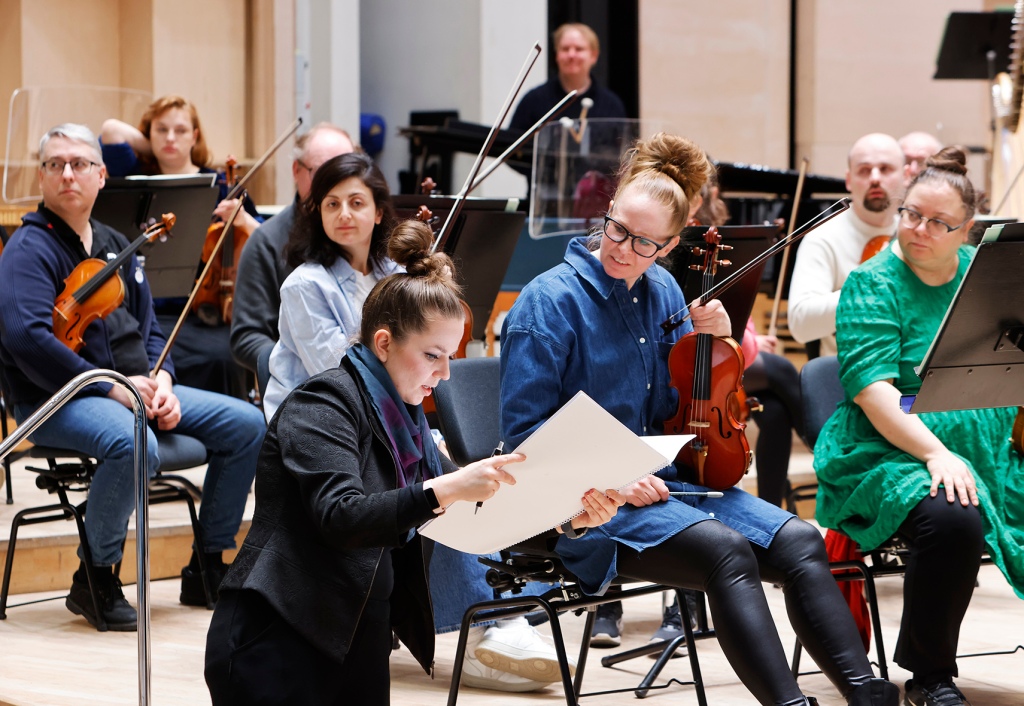
Heard in conjunction with Tampere Biennale on Friday, the evening concert by the Tampere Philharmonic, guest conducted by Olari Elts and featuring soprano Piia Komsi as soloist, brought together four musical works from four intriguing contemporary composers. Titled From Wasteland to Wonderland, the playlist included two premieres, Cecilia Damström’s Wasteland, op. 81 (2021-22) and Eetu Lehtonen’s Hymn (2023), bookended by two classics of our time, Kalevi Aho’s Syvien vesien juhla (The Rejoicing of the Deep Waters, 1995) and Unsuk Chin’s Puzzles and Games from Alice in Wonderland (2017).
The evening’s awe-inspiring primer, Aho’s ten-minute orchestral fantasy is an offshoot of the composer’s then opera-in-progress Before We All Have Drowned (1995-99), where it serves as diegetic music, heard on a recoding by the lead character. Premiered by Lahti Symphony under Osmo Vänskä, Rejoicing of the Deep Waters is scored for triple woodwinds with alto saxophone, four horns three trumpets, three trombones, tuba, timpani, percussion and strings. The title bears double reference, suggesting both the opera’s key subject as well as the deepest layers of our subconsciousness.
Ardent brass heralds set the music in motion, joined by timpani, shrieking woodwinds and piercing strings, colored by percussion. Once introduced, the key elements keep recurring in frenetic manner, conjuring up orchestral nightmares of staggering sounding images. At around four minutes, the symphonic vehemence cools down, but the music is hardly less menacing, for there are juxtapositions of eerie stillness and biting mockery drawn from the ensemble, with mounting intensity, eventually leading the music back to its tempestuous opening. Raging on into its very closing pages, Rejoicing of the Deep Waters closes with a plunge into the abyss.
A hardcore performance for a hardcore piece, Elts and the Tampere Philharmonic delivered a shattering reading of Aho’s orchestral classic. Heard as standalone piece outside the context of the opera, Rejoicing of the Deep Waters can be heard as painfully acute allegory of our troubled times and the perils looming on the horizon.
Speaking of troubled times, Damström’s Wasteland presents us with an orchestral examination of textile overconsumption and its multi-layered ecological and societal ramifications.
“In recent years second hand clothes have become increasingly popular in Scandinavia, and bringing your clothes to a collection is considered a way to “have a clean conscience”. But according to a report by the Finnish Broadcasting Company Yle only around 20 percent of the collected clothes can be sold in shops in Scandinavia. Around 10 percent are burnt immediately and up to 70 percent are sent further to sorting units, usually situated in the Baltic countries or Germany. At this point a small part is used for upcycling, such as fillings for car seats. But most of the clothes are sent to some of the poorest countries in the world, like for instance Mozambique. The black market of cheap bad quality clothes disrupts these countries’ own textile industry. As a large part of the clothes are of too bad quality to wear anymore, they end up in landfills”, the composer writes in her note.
Co-commissioned by the Tampere Philharmonic, the ca. twenty-minute score of Wasteland is cast in five movements on orchestral narrative, accounting the fates of clothes worn perhaps only a few times, which are then tossed away, sorted and eventually burned. The medium being the message, Damström’s musical material in itself is largely recycled from pre-existing sources such as Finnish seasonal hymns, Latin Mass, Carmen, Die Zauberflöte, Rondo alla Turca, Für Elise, Toccata in D minor, The Moldau, a pop song by Maija Vilkkumaa and the State Anthem of the Soviet Union.
Woven together into evocative orchestral dramaturgy, the source material appears in manifold guises: sometimes only a fleeting references are heard as opposed to deliberately blatant, full-on renditions appearing in some of the crucial points within the storyline. Scored for a symphonic ensemble of duple winds with piccolo, four horns, two trumpets, two trombones, tuba, timpani, two percussion and strings, Wasteland was given its world premiere performance in September 2022 by the Norrlandsoperan Orchestra, conducted by Ville Matvejeff.
The opening movement, Wear, comes off as hyperactive Academic Festival Overture, as Damström presents us with a hectic party montage, featuring orchestral costume changes at increasing speed. In the course of the two ensuing movements, Toss and Sort, used clothes are transferred to large sorting halls via an Andante orchestral transportation. At the end of the ride, the ensemble pans out with piled layers of repetition, mounting to vast tutti canvases and gazing upon the sheer mass of waste. Furioso furnaces are lit in Burn, conjuring up symphonic auto-da-fe par excellence. In the concluding Flow the orchestra sails down the river of greenwashing, rendering its final parody before vanishing beyond the horizon.
Conceived with meme-like wittiness and inventive instrumental craft, Wasteland is both fun and serious, its musical designs being both accessible and thought-provoking, without succumbing to fast fashion takes on the Berio Sinfonia (1968-69). Performed with dedication and zeal by the Tampere Philharmonic under Elts, Wasteland was given a powerhouse Finnish premiere.

Heard after the intermission the evening’s second Tampere Philharmonic commission, Eetu Lehtonen’s Hymn (2023) is a ten-minute orchestral memorial provoked by the Aberfan disaster of 1966, in which 144 people, mostly children, were killed in a collapse of colliery spoil tip.
Scored for double winds with contrabassoon, four horns, three trumpets, three trombones, tuba, timpani, two percussion, piano, harp and strings, Hymn begins with ominously oscillating string hue, colored by tam-tam strikes and timpani brushes, combined with menacing air sounds on brass and cracking string pizzicati. As the material unfolds, musical shapes grow more pronounced and agitated, ebbing and flowing between development and fragmentation. Out of the vehemence, a hymn tune emerges, played and hummed, leading the music to its gripping, elegiac conclusion.
Although relatively straightforward in its core build-up, the musical surfaces are awash with fine-tuned colorist detail, lending Hymn with additional expressive potential, well realized in performance by the orchestra and Elts.
The evening’s dazzling finale, Chin’s exquisite Puzzles and Games is ca. twenty-three-minute concertante adaptation from the composer’s opera Alice in Wonderland (2004-07), scored for solo soprano and an orchestra of duple winds doubling piccolos, alto flute, English horn, E-flat clarinet, bass clarinet and contrabassoon, two horns, three trumpets, two trombones, tuba, timpani, three percussion, harp, piano doubling harpsichord and celesta, mandolin, accordion and strings. Consisting of eleven short scenes, Puzzles and Games constitute a virtuoso vocal concerto, calling forth utmost skill and reactivity from its soloist to convey the huge expressive range of the soprano part. There is no easy ride for the orchestra or the conductor either in conveying Chin’s ambidextrous orchestral fabric.
In setting Lewis Carroll’s surreal, dream-like texts, the composer harnesses her creative currents in full measure, coming up with a series of mischievously whimsical, pocket-size musical dramas. Setting the stage in almost impressionistic raiment, Alice – Acrostic unrolls in the manner of a wistful barcarolle, whereas the ensuing If I never reach the garden comes off with nocturnal yearning. Reaching for airy heights, what a curious feeling spins off with apt sense of vertigo. Curiouser, curiouser, in its turn, resorts to Pierrotesque sprechstimme, followed by pointillist opening lines of Who in the world am I?, which then give over to extended vocal musings.
The tale-tail of the mouse, Sleep tight, my ugly baby and Cat’s aria all present us with prime examples of Chin’s extraordinary sense of devising highly developed dramatis personae with ever spot-on musical procedures, often on split-second time-scales. Primed by brief instrumental interlude, Twinkle, twinkle, little star constitutes a flamboyant vocal cadenza accompagnato, paving the way for the take-no-prisoners finale, Speak roughly to your little boy.
Sung with incredible artistry by Komsi, whose impeccable command over Chin’s score was nothing short of miraculous, the performance provided the full house with riveting vocal theater. Appearing in various configurations, the Tampere Philharmonic plunged headlong into the music, sounding out a fabulous performance, well coordinated by Elts. Puzzles and Games is a tricky thing to balance, thus here and there, the orchestra tended to override the soloist. Still, all things considered, their reading was a praiseworthy affair, joyously received by the full house.
Tampere Philharmonic
Olari Elts, conductor
Piia Komsi, soprano
Kalevi Aho: Syvien vesien juhla (The Rejoicing of the Deep Waters, 1995) – Fantasy for orchestra
Cecilia Damström: Wasteland, op. 81 (2021-22) for symphony orchestra (Finnish premiere, Tampere Philharmonic co-commission)
Eetu Lehtonen: Hymn (2023) for orchestra (world premiere, Tampere Philharmonic commission)
Unsuk Chin: Puzzles and Games from “Alice in Wonderland (2007) for soprano and orchestra
Tampere Hall, Main Auditorium, Tampere, Finland
Friday 12 April 2024, 7 pm
© Jari Kallio